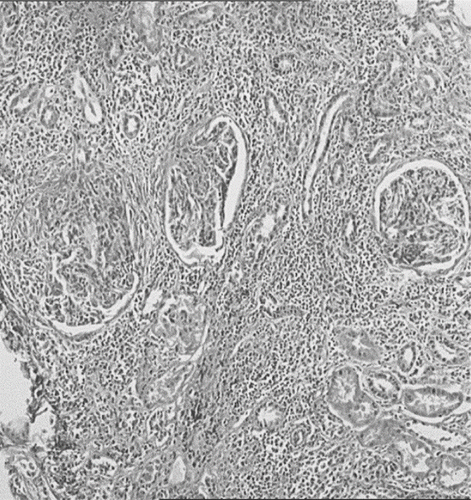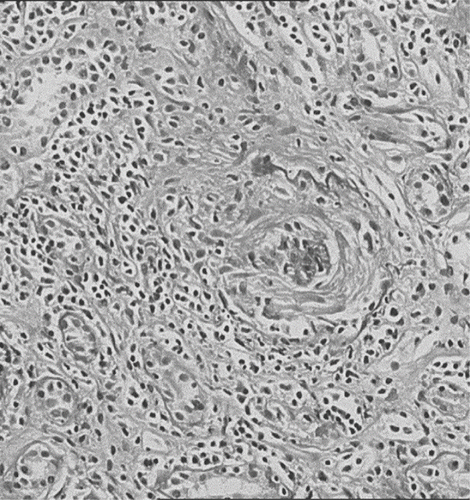Abstract
Propylthiouracil is a drug used in the treatment of hyperthyroidism for more than 60 years. Adverse side effects are seen in 1–5% of patients. Renal complications of the drug including glomerulonephritis and vasculitis are rarely seen. Cases of propylthiouracil-induced rapidly progressive glomerulonephritis and vasculitis are reported in association with antineutrophil cytoplasmic autoantibodies. Here we report a case of positive antineutrophil cytoplasmic autoantibodies rapidly progressive glomerulonephritis (RPGN) associated with propylthiouracil treatment.
INTRODUCTION
Propylthiouracil (PTU) is a drug used in the treatment of hyperthyroidism for more than 60 years. Adverse side effects are seen in 1–5% of patients. The most common adverse effects are mild leukopenia, fever, rash, and arthralgias; less frequent side effects include agranulocytosis, hepatitis, vasculitis and lupus-like syndrome. Renal involvement including glomerulonephritis (GN) and vasculitis are rarely seen.Citation[1–3]] Cases of PTU-induced rapidly progressive GN and vasculitis are reported in association with antineutrophil cytoplasmic autoantibodies (ANCA).Citation[4] This report is of a case of ANCA positive rapidly progressive glomerulonephritis (RPGN) associated with PTU treatment.
CASE REPORT
A fifty-year-old male patient was admitted to the hospital with fatigue, fever, nausea, and vomiting. He was receiving PTU (200 mg/day) and propranolol (40 mg/day) for hyperthyroidism and ramipril (5 mg/day) for hypertension for three months. He had headache, muscular weakness, dyspnea, and 20 kg weight loss in the last two months.
Upon admission, his body temperature was 37°C, pulse rate was 120 beats/min, blood pressure was 140/80 mmHg, and respiratory rate was 18 breaths/min regular. Thyroid gland enlargement was apparently seen. A systolic heart murmur was audible in the apex (Levine 2/6). Laboratory examination revealed hemoglobin 10.8 g/dL, Htc 31.4 %, WBC 9380/mm3, ESR 78 mm/h, CRP 152 mg/L (0–5), RF 68.7 IU/mL (0–15), creatinine 2.17 mg/dL, BUN 40 mg/dL, albumin 3.1 g/dL. For urinalysis, there was hematuria with 1940 mg/day proteinuria (volume: 2980 mL/day, creatinine clearance: 36.7 mL/min). Thyroid function tests were in accordance with hyperthyroidism; fT3: 9.89 pg/mL (1.7–3.7), fT4 4.14 ng/dL (0.7‐1.48), TSH 0.0 IU/mL (0.35–4.94). Antinuclear antibody, anti-dsDNA, C3, C4, and IgM were normal, fibrinogen 9.0 g/L (1.75-4), and IgG and IgA levels were high; c-ANCA was negative but p-ANCA was 3+ positive. Chest and Water's x-ray and abdominal ultrasound examination were within normal limits. Renal biopsy showed necrotizing crescentic GN and severe tubulointerstitial nephritis (see and ). Immunofluorescence showed no immune deposits. These findings suggested ANCA-associated vasculitis.
Figure 1. Dense mononuclear cell infiltration of interstitium with tubular atrophy and crescentic glomeruli, HE × 100.

Figure 2. Dense inflammation and atrophy of tubulointerstitium, obliteration of glomerulus with crescent formation, PAS × 200.

Propylthiouracil was withdrawn and propranolol was increased to 120 mg/day for the treatment of hyperthyroidism. Pulse methylprednisolone 10 mg/kg/day for three days and pulse cyclophosphamide (500 mg as a single dose) was given. Methylprednisolone 1 mg/kg/day as maintenance therapy was continued. After this treatment, his complaints were resolved. On the 30th day of hospitalization, radioactive iodine (15mCi) was given for hyperthyroidism, and the patient was discharged with BUN 60 mg/dL and creatinine 1.3 mg/dL.
The patient was receiving 1 mg/kg/day oral steroid maintenance treatment at the end of first month of treatment and was hospitalized for the second cyclophosphamide pulse treatment (500 mg, single dose). At that time, laboratory examination revealed ESR 27 mm/h, BUN 34 mg/dL, creatinine 1.0 mg/dL, p-ANCA 2+, 682 mg/day of proteinuria, and thyroid function tests within the normal ranges. The patient was discharged and followed with oral steroid treatment, which was gradually decreased and given for a total of six months. During this time, cyclophosphamide pulse treatment once per month continued. At the end of sixth month, his renal functions were within normal ranges.
DISCUSSION
Propylthiouracil-induced vasculitis associated with ANCA has been first described by Dolman et al.,Citation[5] and later cases are reported by the other authors.Citation[4] In most of these patients, symptoms appear after a few years of taking PTU, but some patients manifest symptoms within one month or even one week of therapy. Symptoms such as fever, fatigue, polyarthritis, myositis, scleritis, pleuritis, alveolar hemorrhage, pericarditis, nephritis, hepatitis, and skin ulceration have been reported. The renal biopsy in these patients showed pauci-immune (without immune deposits) necrotizing crescentic GN. Although the pathophysiology of pauci-immune nephritis has not been clarified, it has been known as ANCA-associated crescentic GN.Citation[6],Citation[7] In all reported cases, indirect immunofluorescent testing for ANCA revealed a perinuclear pattern.Citation[2],Citation[4]
In treatment, early diagnosis and cessation of the drug are first choice. Although discontinuation of drug therapy leads to improvement and even normalization of renal function, some patients may require steroid and immunosuppressive treatment.Citation[2],Citation[4] In this case, detoriation of renal function and positive pANCA titers continued in the first month of therapy. Despite the normalization of BUN-creatinine levels due to intensive immunosuppressive and corticosteroid therapy, ANCA titers were positive for three months. We believe that intensive therapy for a longer time will be appropriate to minimize renal damage. Depending on the widespread use of PTU treatment and the increase in the probability of pANCA related GN, we suggest that urinalysis, BUN, creatinine, and ANCA measurements performed before and after PTU treatment at regular intervals will be useful in preventing severe renal insufficiency.
REFERENCES
- Reinhart SC, Moses AM, Cleary L, et al. Acute interstitial nephritis with renal failure associated with propylthiouracil therapy. Am J Kidney Dis. Oct, 1994; 24(4)575–577
- Kudoh Y, Kuroda S, Shimamoto K, et al. Propylthiouracil-induced rapidly progressive glomerulonephritis associated with antineutrophil cytoplasmic autoantibodies. Clin Nephrol. Jul, 1997; 48(1)41–43
- Winters MJ, Hurley RM, Lirenman DS. ANCA-positive glomerulonephritis and IgA nephropathy in a patient on propylthiouracil. Pediatr Nephrol. Apr, 2002; 17(4)257–260
- Kitahara T, Hiromura K, Maezawa A, et al. Case of propylthiouracil-induced vasculitis associated with anti-neutrophil cytoplasmic antibody (ANCA); review of literature. Clin Nephrol. 1997; 47(5)336–340
- Dolman KM, Grans ROB, Vervaat TJ, et al. Vasculitis and antineutrophil cytoplasmic autoantibodies associated with propylthiouracil therapy. Lancet. 1993; 342: 651–652
- Booth AD, Pusey CD, Jayne DR. Renal vasculitis—an update in 2004. Nephrology Dialysis Transplantation. 2004; 19: 1964–1968
- Yuasa S, Hashimoto M, Yura T, et al. Antineutrophil cytoplasmic antibodies (ANCA)-associated crescentic glomerulonephritis and propylthiouracil therapy. Nephron. 1996; 73(4)701–703